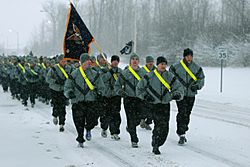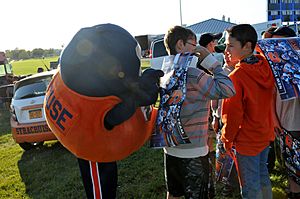Fort Drum facts for kids
Quick facts for kids Fort Drum |
|
|---|---|
| Jefferson County, New York Near Watertown |
|

1st Battalion, 87th Infantry Regiment, on a run
|
|
| Area | 107,265 acres (434.09 km2) |
| Site information | |
| Owner | U.S. Army |
| Controlled by | 10th Mountain Division |
| Site history | |
| Built | 1908 |
| In use | 1908-present |
|
Fort Drum, New York
|
|
|---|---|
| Country | United States |
| State | New York |
| County | Jefferson |
| Town | Le Ray |
| Area | |
| • Total | 14.45 sq mi (37.43 km2) |
| • Land | 14.34 sq mi (37.14 km2) |
| • Water | 0.11 sq mi (0.29 km2) |
| Elevation | 590 ft (180 m) |
| Population
(2020)
|
|
| • Total | 15,896 |
| • Density | 1,108.51/sq mi (428.01/km2) |
| Time zone | UTC−5 (Eastern (EST)) |
| • Summer (DST) | UTC−4 (EDT) |
| ZIP Codes |
13602–13603
|
| Area code(s) | 315 |
| FIPS code | 36-26759 |
Fort Drum is a large base for the U.S. Army in Jefferson County, New York. It's also a special area called a census-designated place (CDP). In 2010, about 12,955 people lived in the CDP part of the base. Fort Drum is the home of the 10th Mountain Division, a special group of soldiers.
The base covers a huge area of about 107,265 acres (434 square kilometers). Winters in this part of New York can get very cold, sometimes as low as -30 degrees Fahrenheit (-34 degrees Celsius). Fort Drum's main job is to lead the army units stationed there. It also helps other army and reserve units train and prepares nearly 80,000 troops for missions every year.
| Top - 0-9 A B C D E F G H I J K L M N O P Q R S T U V W X Y Z |
History of Fort Drum
Fort Drum has a long and interesting history. It started as a training site over 100 years ago.
Early Military Presence
The area that is now Fort Drum was first used for military training in 1908. It was called Pine Camp back then. The army bought land the next year to make it a permanent training base.
Before this, the army was in the North Country region as early as the 1800s. This was before the War of 1812.
- In 1809, U.S. soldiers were sent to Sackett's Harbor. Their job was to stop smuggling between New York and Canada.
- During the War of 1812, Sackett's Harbor became a very important place for the U.S. Navy and Army.
- A big shipyard was built there, and 12 warships were made. Many soldiers and skilled workers moved to the town.
- Later, in the 1830s and 1840s, the U.S. bought more land in Sackets Harbor. They built Madison Barracks there for artillery units.
Pine Camp's Beginnings
In 1908, Major General Frederick Dent Grant came to the Pine Camp area. He trained with 2,000 regular soldiers and 8,000 militia members. General Grant, whose father was former President Ulysses S. Grant, thought the Pine Plains area was perfect for military exercises. In 1909, money was set aside to buy land for Pine Camp. Summer training continued there for many years.
The camp became famous in 1935. This was when the biggest peacetime military exercises in American history happened there. About 36,500 soldiers came from all over the Northeast. They marched, attacked, and defended in war games on 100 square miles (259 square kilometers) of land. The exercises were a success. The War Department then bought another 9,000 acres (3,642 hectares) of land.
LeRay Mansion: A Historic Home
The LeRay Mansion was built in the early 1800s. It was named after James LeRay de Chaumont. Over the years, this mansion has been used for many things. It served as a home for the base commander and a place for important visitors. It also hosted formal military parties.
Today, the mansion is still used to house high-ranking visitors. This helps keep the historic building in good condition. The LeRay Mansion is listed on the National Register of Historic Places. This means it's an important historical site.
Growing During World War II
When World War II started in Europe, Pine Camp grew a lot. The Army bought another 75,000 acres (30,351 hectares) of land. This meant 525 local families had to move. Five whole villages disappeared, and others became much smaller. Three thousand buildings, including schools, churches, and a post office, were left empty.
By late 1941, 100 areas of land were taken over. Workers built a whole city in just 10 months. It cost $20 million. This new city was made to house the army divisions that would train at Pine Camp.
Eight hundred buildings were constructed. These included barracks, mess halls, warehouses, and recreational buildings. There were also guardhouses and a hospital. Building was tough because the winter of 1941-42 was one of the coldest ever in the North Country.
Three important divisions trained at Pine Camp during the war:
- The 4th Armored Division
- The 45th Infantry Division (United States)
- The 5th Armored Division
During the war, the base also held captured Italian and German soldiers. Some of these prisoners were allowed to work on local farms. One Italian and six German prisoners who died there are buried in Sheepfold Cemetery.
Becoming Camp Drum and Fort Drum
Pine Camp was renamed Camp Drum in 1951. It was named after Lieutenant General Hugh A. Drum. He was a key leader in the U.S. Army during World War I and World War II. During and after the Korean War, many units trained here. They used the area's unique land and weather conditions.
In 1959, some special chemicals were tested in certain areas of the camp. These chemicals were later used for clearing plants in other parts of the world.
In 1974, Camp Drum became Fort Drum. A permanent group of soldiers was assigned to live there. In 1980, a group of engineers moved to Fort Drum.
On September 11, 1984, it was announced that Fort Drum would be the new home of the 10th Light Infantry Division. This division's job is to be ready to quickly move by air, sea, or land anywhere in the world. They must be prepared to fight and win as soon as they arrive. The first troops arrived on December 3, 1984. The unit was officially activated on February 13, 1985. It was then called the 10th Mountain Division (Light Infantry). The division was at its full strength by 1989.
Between 1986 and 1992, many new buildings were constructed. Also, 35 miles (56 kilometers) of roads and 4,272 family homes were built. This cost about $1.3 billion.
In 2013, Fort Drum was considered as a possible location for a new missile defense site in the Eastern United States. In 2014, a large power plant was built at the base. It uses biofuel to create energy. This is part of the U.S. military's effort to use more renewable energy.
In 2015, Diana M. Holland made history at Fort Drum. She became the first woman general there. She was also the first woman to be a deputy commanding general in one of the Army's light infantry divisions, the 10th Mountain Division.
Current Units at Fort Drum
Many different military units are stationed at Fort Drum today.
- 10th Mountain Division
- 1st Brigade Combat Team, 10th Mountain Division
- 2d Brigade Combat Team, 10th Mountain Division
- Combat Aviation Brigade, 10th Mountain Division
- 10th Mountain Division Artillery, 10th Mountain Division
- 10th Mountain Division Sustainment Brigade
- American Red Cross (ARC)
- U.S. Army Materiel Command FSC (LAO)
- Wheeler-Sack Army Airfield
- 20th Air Support Operations Squadron (United States Air Force)
- Air Force Weather, 20th Air Support Operations Squadron (20th ASOS)
- Fort Drum Criminal Investigation Command (CID)
- Non-commissioned Officers Academy
- Naval Reserve Center - Fort Drum
- 1st Battalion (Infantry), 314th Regiment
- 2d Battalion (Logistics Support), 313th Regiment
- 3d Battalion (Field Artillery), 314th Regiment
- 7th Legal Support Organization (7th LSO)
- 725th Ordnance Company (EOD)
- 174th Fighter Wing Air-Ground Gunnery Range
- 1215th Garrison Support Unit (USAR)
- Guthrie Ambulatory Health Care Clinic
- U.S. Air Ambulance Detachment
- 760th Ordnance Company (EOD)
- 63d Ordnance Battalion (EOD)
- 91st Military Police Battalion
- 7th Engineer Battalion
- 630th Engineer Company (Route Clearance)
- 642d Engineer Company (Support)
- Company B (Field Maintenance), 427th Brigade Support Battalion
- 1427th Transportation Company (Medium Truck)
- Company C, Recruiting and Retention Command, NYARNG
- Maneuver Area Training Equipment Site (NY MATES), NYARNG
- 925th Contracting Battalion
Geography and Location
Fort Drum is located in the eastern part of Jefferson County. It also reaches into Lewis County. The base covers about 14.45 square miles (37.35 square kilometers) of land and water.
Several towns and villages are near Fort Drum:
- Antwerp
- Leray
- Philadelphia
- Wilna
- Diana
- Black River
- Carthage
- Evans Mills
- Natural Bridge
The closest city is Watertown, which is about 13 miles (21 kilometers) southwest. Watertown is where many people from Fort Drum go for shopping and services. The Indian and Black rivers flow along parts of the base's border.
People and Community
In 2020, the population of Fort Drum was 15,896 people. The base is a diverse community. In 2000, about 64.2% of the people were White, and 19.8% were African American. About 13.3% of the population was Hispanic or Latino.
Many families with children live on the base. In 2000, about 75.3% of households had children under 18. Most households were married couples. The average age of people living at Fort Drum was 22 years old.
Jobs and Housing
Fort Drum offers many job opportunities both on and off the base. Civilian jobs include day care providers, teachers, nurses, and cleaning staff. There's also a program called "Teen-In-Hire" that helps high school students find jobs.
Finding a home on the base can sometimes be tricky because many families move there. However, families can stay temporarily at places like the Fort Drum Inn, cottages, or the historic LeRay Mansion. These places are managed by Fort Drum Lodging. Soldiers and their families can also stay at hotels near the base.
Education at Fort Drum
The Fort Drum area is served by two main school districts:
- The Carthage Central School District
- The Indian River Central School District
Students living in the Richard Hills Housing Community go to the Carthage school district. Those in Adirondack Creek, Crescent Woods, and Monument Ridge housing go to the Indian River district. Some parts of Fort Drum are not in any school district.
Local colleges and universities include:
- State University of New York North
See also
 In Spanish: Fort Drum para niños
In Spanish: Fort Drum para niños




